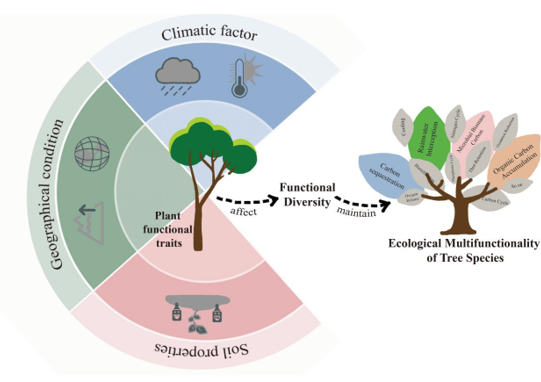Urban Center Tree Communities Show Higher Ecosystem Multifunctionality than Suburban Ones
Urban trees play a far more complex role in shaping city life than previously understood, according to new research from scientists in Shenyang, China. The study shows that tree communities in city centers can provide stronger ecological benefits than those in suburban areas, but these benefits depend heavily on environmental conditions and the mix of tree traits.
Researchers from the Chinese Academy of Sciences' Institute of Applied Ecology (IAE) analyzed 12 common tree species along an urban-to-suburban gradient in Shenyang. The research team, led by Dr. XU Sheng and Dr. HE Xingyuan, discovered that urban forests scored higher in “multifunctionality” (a measure of how well tree communities deliver multiple benefits, such as storing carbon, cooling air, improving humidity, removing pollutants, and enhancing human well-being).
The researchers measured how tree traits interact with environmental factors, and their findings highlight what they call “threshold effects.” In scientific terms, a threshold marks the point where small changes can sharply alter outcomes. In this case, the researchers found that few specific factors such as net photosynthetic rate (how efficiently trees convert sunlight into energy) and functional evenness (how evenly traits are distributed across species) were decisive.
At higher thresholds, air humidity and the average community photosynthetic rate (known as CWM Pn) emerged as the strongest drivers of tree multifunctionality. At lower thresholds, functional evenness played a leading role, though its effect varied depending on the mix and number of tree species. In addition, the researchers found that CWM Pn and functional evenness exerted their greatest influence when they crossed thresholds of about 61% and 64% respectively.
The study also revealed that the heterogeneity between urban and suburban environments significantly influenced the driving mechanisms of multifunctionality. In urban centers, the effects of environmental factors and average species traits (CWM traits) were more direct, driving the ecological functions of the trees. In suburban areas, however, the drivers were more complex, shaped by multiple interacting and cascading factors rather than a single dominant influence.
These findings offer a new perspective for understanding the driving and maintenance mechanisms of urban forest ecosystem services under complex climate change conditions.
The study, titled “Functional Evenness and Community-Weighted Mean Traits Jointly Drive Ecological Multifunctionality in Urban Forests,” has been published in the Journal of Plant Ecology.

Figure 1. Conceptual framework of how tree traits and environmental factors interact to shape urban forest multifunctionality (Image by WANG Ruiting).



